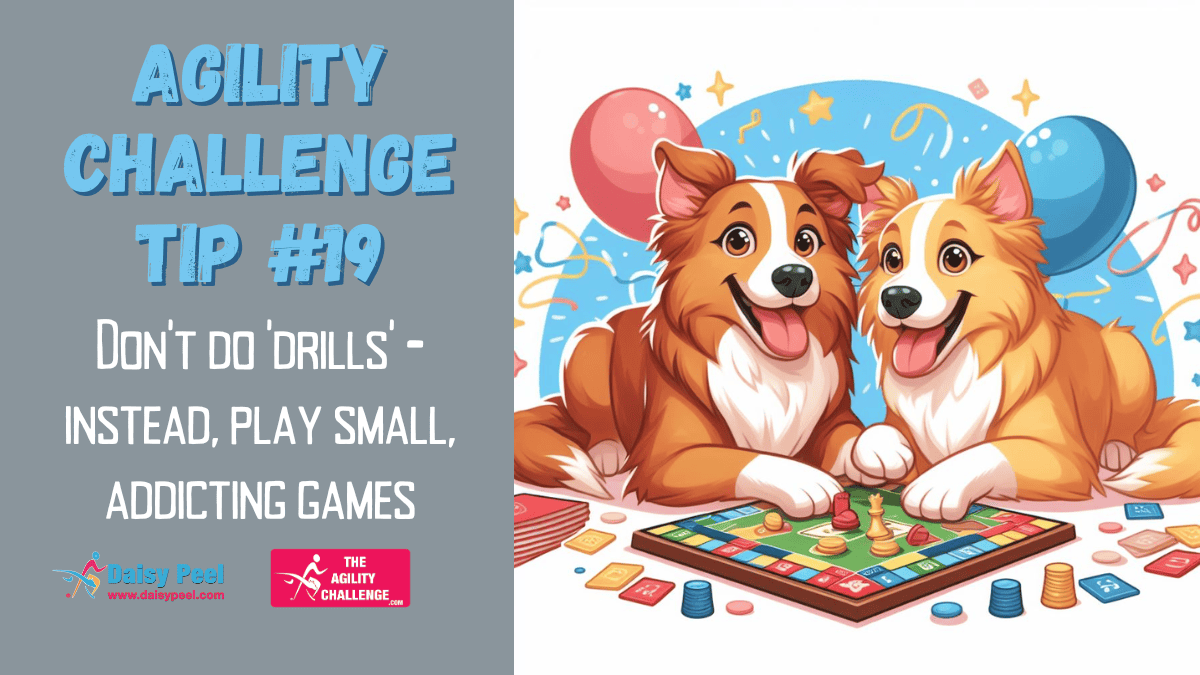As dog trainers, I think we’re probably a step ahead of many in other pursuits with this one. If you’re going out to practice with your dog to do ‘drills’, you’ll likely find that your dog gets disinterested pretty quickly. Most of us work hard to figure out how to weave training in to games we play with our dogs, so that our dogs don’t really know the difference between play and training! I know I do. Training is play is training.
The term ‘drill’ evokes a sense of drudgery and meaninglessness. It’s mechanical, repetitive, and boring – as the saying goes, drill and kill. Games, on the other hand, are just the opposite! They mean fun, connectedness, and passion – all the things we want with our dogs on and off the agility course! And because of that, skills improve faster when they’re looked at through the lens of games, rather than just drills.
In The Little Book of Talent, Daniel Coyle gives us some examples of world-class performers who engaged in small, addictive games to improve their skills.
- Young golfer Rory McIlroy chipping golf balls in to the family dryer
- Warren Buffett as a child going door to door selling chewing gum and trying to figure out which flavor sold best
- Keith Richards in the early days of The Rolling Stones trying to decode a riff on an old blues record
What these examples have in common is that they have a juicy, addictive sense of involvement, fun, and excitement.
As a dog trainer and handler, you’re not only a student (of the game, of your instructor, etc.), but you’re also a coach for your dog. And, good coaches, whether it’s to your dog or to your own agility students, share a knack for transforming the most mundane activities – especially the mundane activities – into games.
The governing principle is this: if it can be counted, it can be turned into a game. Working on sit stays can be boring if you let it. But, count the number of times you and your dog do a perfect sit stay and give yourself a point for each perfect sit stay, and it becomes a game. Track your progress, and see how many points you score over a week (of 5 minute a day training!). The next week, try to score more!
***
ADDENDUM FOR THIS WEEK:
Despite being able to look at a long list of accomplishments that clearly illustrate a level of skill, I’m not ashamed to say that I chronically feel a lack self-confidence these days. It just goes to show that regardless of what level of competition or skill you’re at, it’s still possible to feel not good enough, to doubt yourself and your skill. This is not something I say in an effort to garner compliments; really, no amount of complimenting changes that little voice inside my head that IS self-doubt. The only person who can really quiet that voice, or at least learn to ignore it when the evidence says it’s lying, is ME – and it’s the same with ALL of those of us who struggle with confidence!
I used to be pretty confident, arrogant even, about my skills. What changed? A lot of it in my case has to do with adopting the principles of purposeful practice, as well as the changing level of difficulty of the courses I love to run, and the increased amount of training required. As has been mentioned in previous Talent Tips, engaging in purposeful practice can be downright uncomfortable. Growth can be uncomfortable. And over the past few years, certainly, I have engaged in a LOT of growth, taking a different direction with my own training, learning to adapt and improve to meet the changing challenges of international courses as THEY constantly change.
Some of this is also a matter of framing, and over the past few years I’ve slowly but surely come around to viewing this discomfort and lack of absolute self-confidence as something else. After all, we can be at a competition and experience a range of physical sensations that we might describe as nerves, being anxious, being scared, terrified, etc., OR, we might describe those same physical sensations as being ready, aroused, aware, and up on our toes. Similarly, not being completely and totally confident in an outcome or in our abilities doesn’t need to mean that we should doubt our abilities, or ourselves.
If you’re interested in the sports psychology side of things and want to dig deeper, one of my favorite Sports Psychology audio courses, called The Pscyhology of Performance, is a great audio program to check out (you can find it HERE). In one section, the author asks an athlete to focus on her competitive performance with these questions:
- Do you know what the job is?
- Can you DO the job?
- WILL you do the job?
The athlete was going in to a game where she really wanted a certain level of performance to prove herself to the coach of the opposing team, who used to be HER coach, and she was also distracted by the presence of that coach on the opposite side of the court. But in the moment, during the game, or the run, those questions are really all that matter, especially the last one! So, these are the types of questions that I remind myself of at a competition if I feel like I’m getting distracted by mental chatter, instead of focusing on being fully in the present moment.

